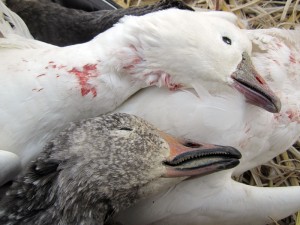The spring thaw is finally underway in the northern tier and light geese have arrived in the Dakotas in significant numbers. While some juvenile birds remain in parts of Nebraska and Iowa, light geese are another step closer to the 49th parallel and the return to their arctic breeding grounds.
Hello folks, and, as always, welcome to Waterfowler.com.
The spring migration is generally a hurry-up and wait process. Ducks and geese are in a hurry to return to the breeding grounds and they wait for a break in the weather to push northward. Canada geese and mallards, being more cold tolerant and stubborn, generally arrive in the south last and are the first to push north – arriving ahead of light geese.
As southerly winds and warm temperatures pushed to the far north this past week, so did waves of waterfowl and songbirds. Flights of Sandhill Cranes were reported in northern portions of the Mississippi and Central Flyways along with the return of many duck species to areas with open water.
Light goose numbers in Missouri have dropped significantly as the remaining juvenile birds moved north and Hunters in western Minnesota and the Dakotas have welcomed their arrival.
While light goose hunting is a great reason to head to the field during the spring months, the spring migration provides excellent opportunity for photo enthusiasts to capture images of ducks and geese as they make their way back to the breeding grounds. Open pockets of water can hold incredible numbers of birds in full breeding plumage and extended daylight hours provide ample opportunity to sneak out after work and capture a few great photographs.
Whether you are a seasoned wildlife photographer or budding amateur, the following tips can make your next photography excursion a successful one:
1) Make sure batteries are charged and transported in internal jacket pockets – cold temperatures can drain batteries quickly.
2) Good Camouflage is a must – and portable blinds or ghillie suits work best.
3) Keep the sun at your back and make sure your subject isn’t in the shadows unintentionally.
4) Use a monopod for added stability (even when shooting moving subjects).
5) Scout (just as you do when hunting). It is better to arrive at a resting or feeding area before the birds do. Stalking photo subjects is difficult at best.
6) Use faster shutter speeds for moving targets to prevent blurred images.
7) In low light – increase the ISO speed of your camera if settings allow.
8) Many state and local wildlife areas have permanent blinds for bird watchers, be sure to check all local possibilities.
9) Take an abundance of memory cards. Editing should be done at home and not in the field when you might miss a golden opportunity.
10) Pack a lunch and thermos and just enjoy a good day in the field. The friesh air is a blessing after a long, cold winter.
Until our next report, we look forward to seeing your photos in the Waterfowler.com gallery and forums.






